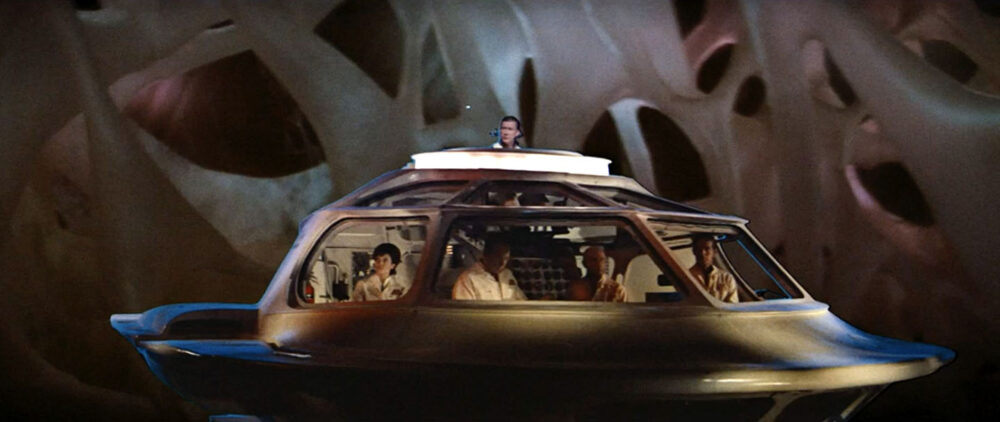Swallow the Micro-Robot
3D printed micro-robots will one day be able to precisely deliver drugs or treat hard-to-reach tumors.
Handling objects smaller than the eye can see presents many challenges. In Richard Feynman’s 1959 talk, “There’s Plenty of Room at the Bottom,” the Nobel Prize-winning physicist considered the problem of how to assemble and manipulate matter one molecule, or even atom, at a time to control things at the very bottom of the scale for physical size. As things get smaller and smaller, the relative forces change. Atoms don’t work the same at ultra-tiny and vastly large scales.
In addition to discussing miniaturized motorized machines, anticipating the miniaturization of computers through integrated circuits, and writing an encyclopedia on a pinhead, Feynman marveled at the prospect of figuring out how to “swallow the surgeon”—that is, how to make a tiny robot that could travel through blood vessels to carry out medical procedures where needed. To create any of these, new technology and tools would need to be invented.
A few years later, the science fiction adventure film Fantastic Voyage captured that vision. A submarine crew who are shrunk to microscopic size venture into the body of an injured scientist to repair damage to his brain. Although we haven’t developed the technology from Honey, I Shrunk the Kids or Ant-Man to miniaturize people to take a ride through the human body, it may not be long before doctors are remotely controlling micro-robots through your bloodstream to deliver drugs to specific and challenging-to-reach places, opening up the doors to treatments never seen before.
In many research laboratories around the world, microscopic treatments are being conceptualized, assembled, and tested. One such lab is that of Mingming Wu, an engineering professor at Cornell University, who creates “micro-swimmers”—maneuverable miniaturized robots that zip through fluids like tiny, remote-controlled single-celled organisms. But, as predicted by Feynman, there’s a major problem: How do you design, manufacture, and operate something so small that it necessitates a super-strong electron microscope just to see?

Ultrasonic bubble-based propulsion
Wu says that for her and post-doc Tao Luo, now a professor at Xiamen University in China, one of the issues was replicating how microorganisms harness chemical energy to make them go. One major avenue for steering micro-swimmers is based on magnetism, but according to Wu, magnetic fields don’t have the strength to reach far in the body—or the precise control needed to manipulate tiny internal objects carefully.
That’s why Wu and Luo started to think about manipulating miniature robots in the body using high-frequency ultrasound waves, the same sort of technology approved by the U.S. Food and Drug Administration for imaging during pregnancies. Using ultrasound, Wu and Luo demonstrated that they could move teeny, hang-glider-shaped, 3D-printed vehicles through a saline solution. At the back of the micro-swimmers, which look like the ship from the classic arcade game Space Invaders, are two cavities containing an air bubble in a liquid chamber. When hit with ultrasound waves, they oscillate, generating enough force to thrust the micro-swimmers forward.
You have to figure out how to control a massive school of micro-swimmers to actually transport a drug or cut out a tumor.
Each of these bubble-containing chambers, however, has different sized openings that face towards the fluid, enabling control of the direction of the streaming flow and, thus, steering capacity. The micro-robot advances in a straight line when the streaming forces from the two bubbles are the same. When the streaming forces differ, the micro-swimmer rotates and moves along a curve, which bends depending on the frequency of the ultrasound.
A microscopic medical army
But where the rubber meets the road to actualize the medical potential for micro-swimmers is jumping from the still, controlled liquid environment in a sterile lab dish to the turbulent, living canals of the human body. There is no way that this could be done with a single microscopic micro-swimmer—that would be like expecting a single window washer to clean the world’s tallest skyscraper. In the body, you have to figure out how to control a massive school of micro-swimmers (in the range of thousands to billions, depending on the size of the robots) to actually transport a drug or cut out a tumor.
“The ability to tune the frequency to activate each of the bubbles is a really deductive concept, but it’s tricky to control several adjacent micro-swimmers with ultrasound,” says Juliane Simmchen from the Institute of Physical Chemistry and Electrochemistry at Dresden University of Technology, who propels micromotors with chemical reactions. She also thinks that flexible hydrogels, and not rigid polymers like the ones used by Wu and Luo, are the way to create inexpensive, biocompatible, and controllable swarms of micro-swimmers.
Yuebing Zheng, a mechanical engineer at the University of Texas at Austin, who uses optics instead of ultrasound to power micro-robots, thinks that the next step toward biomedical applicability is creating swarms of fully equipped autonomous robots, which he likens to a colony of ants or a school of fish. “The micro-swimmers will need to be equipped with everything, from the propulsion system to sensors and a means for computation and communication. The eyes and brain will all be on board so that the group can collaborate.”
While it may be hard to imagine fitting all the components of a self-autonomous robot on a device smaller than the period at the end of this sentence, it was once even harder to imagine how a computer far more powerful than the ones which once filled an entire room could fit in your hand. With research on micro-robots currently advancing in rodents, clinical studies in humans are destined to begin in the next few years, meaning that in about a decade there could be a remote-controlled microscopic medical army healing you from the inside.
















